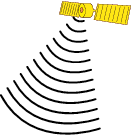The Mysteries of Orbits
Beth M. / Physics 337 / 19 May 1997

When one begins to study satellites he or she is bound to find out
that orbits are an important part of the whole study. An orbit is the path
of a body through space and has many functions. An orbit is what keeps
a satellite alive. They control the speed, distance, and the height of
where a satellite is and how long it will remain there. There are so many
basic questions out there about launching satellites and what happens after
they are launched. Learning about orbits will help one answer these questions
and at the same time will give him or her a better understanding of how
they work.
TYPES OF ORBITS
There are many types of orbits and they work in a variety of ways.
One type of orbit is known as a north-south orbit. These orbits are also
called polar orbits because they pass near the north and south poles. With
a polar orbit a satellite will be able to pass every spot on the earth's
surface. This fact makes them a favorite for military spy satellites. There
are two other important types of orbits and they are known as synchronous
orbits. Synchronous simply means "matched in time." A geosynchronous
orbit is always directly above the equator. The orbit time is matched in
time with the spin of the earth. A sun-synchronous orbit circles the earth
in a north-south direction. Each time the satellite passes overhead the
sun is always in the same position. There are many other types of orbits
but these are the most common.
SHAPES OF ORBITS
Did you ever wonder about the shape of an orbit? One always speaks
of an orbital shape being circular, but most times that is not the case
at all. The shape of an orbit of course depends upon all of the different
circumstances involved, but the essential form that they take is elliptical.
There are certain points in an orbit called foci. When the orbital shape
is that of an ellipse the center of the earth will be at either
one of the foci at all times. When the orbital shape is that of a circle
both foci will be at the same point, the earth will be at the center, and
the speed of the satellite will remain the same the entire time.
PREPARATION AND PLACING
INTO ORBIT
Many factors need to be considered before launching a satellite into
orbit. These factors are very important to the life of the satellite. Before
a flight scientists must decide what sort of orbit is needed and how high
it should be above the Earth. A satellite must be placed into an effective
orbit so as to begin circling the Earth at the correct speed. Without that
a satellite would simply fall to the ground. As one can see, before launching
a satellite scientists have important jobs to do and information to find.
Launching a satellite is not an easy process - there are many tasks involved.
HOW
A SATELLITE STAYS IN ORBIT
What in the world keeps a satellite in orbit? Well, many things are
needed and they must be maintained throughout the life of the satellite.
A satellite circling the earth does not slow down or fall back to earth
because there is neither air nor anything else causing friction which would
slow it down or maybe even "kill" it. The force brought about
by the speed of a satellite is known as centrifugal force. While in orbit,
the centrifugal force pulling it upward exactly matches the force of gravity
pulling it downwards. This balance between gravity and centrifugal force
is what essentially keeps a satellite held in orbit.
CONCLUSION:
As one can see, the types of orbits and how they are used can either
make or break a satellite. A scientist must make sure that his or her data
is precise and the measurements are accurate. They must decide on the best
type of orbit and how it should be used. Many factors go into the launching
of a satellite into orbit and hopefully one now has a better understanding
of how everything works. Hopefully the "mystery" has been solved.
REFERENCES
"Orbits." Funk and Wagnalls New Encyclopedia. New
York: Funk and Wagnalls Inc., 1986.
"Orbits." World Book's Young Scientist. Chicago: World
Book Inc., 1990.
Waters, Tom. "Space Satellites." The New Book of Popular
Science. Connecticut: Grolur
Incorporated, 1996.
White, Jack. Satellites of Today and Tomorrow. New York: Dodd,
Mead, and Company, 1985.